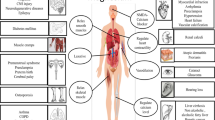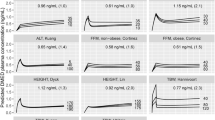Abstract
1,1′-Diethyl-2,2′-cyanine (decynium22) and 1,1′-diisopropyl-2,4′-cyanine (disprocynium24) are highly potent inhibitors of the extraneuronal monoamine transporter. When given as i.v. bolus injections (4 μmol kg−1) to anaesthetized rabbits, both drugs elicited a transient fall in blood pressure without altering heart rate. The observed maximum fall in diastolic blood pressure was 59% after decynium22 and 43% after disprocynium24 administration. The pharmacokinetics of decynium22 and disprocynium24 were similar; they were characterized by short half-lives for elimination (8.2 and 4.5 min, respectively) and very high plasma clearances (173 and 180 ml kg−1 min−1, respectively).
The mechanism underlying the blood pressure-lowering effect of decynium22 was explored in the isolated incubated rabbit aorta. Decynium22 antagonized the noradrenaline-induced contraction; the pA2 for this interaction was 7.6, and the slope of the corresponding Schild plot was unity. In a membrane preparation from rat myocardium, decynium22 as well as disprocynium24 inhibited the specific binding of [125I]-2-[β-(4-hydroxy-3-iodophenyl)-ethy-laminomethyl]-tetralone (125I-HEAT), a selective ligand to α1-adrenoceptors. The Ki's were 5.3 and 240 nmol l−1 for decynium22 and disprocynium24, respectively. The type of binding inhibition by decynium22 was competitive.
It is concluded that the two inhibitors of extraneuronal monoamine transport decynium22 and disprocynium24 lower blood pressure by blocking α1-adrenoceptors. A comparison of their potencies in blocking extraneuronal monoamine transport and α1-adrenoceptors clearly indicates that disprocynium24 is more suitable for studies designed to determine the role of extraneuronal monoamine transport in vivo. Considering its very fast elimination kinetics, disprocynium24 must be administered by constant rate-infusions in order to avoid large fluctuations of plasma levels.
Similar content being viewed by others
References
Arunlakshana O, Schild HO (1959) Some quantitative uses of drug antagonists. Br J Pharmacol Chemother 14:48–58
Baker SP, Potter LT (1980) Cardiac β-adrenoceptors during normal growth of male and female rats. Br J Pharmacol 68:65–70
Benet LZ, Galeazzi RL (1979) Noncompartmental determination of the steady-state volume of distribution. J Pharm Sci 68:1071–1074
Bradford MM (1976) A rapid and sensitive method for the quantification of microgram quantities of protein utilizing the principle of protein-dye binding. Anal Biochem 72:248–254
Bylund DB, Eikenberg DC, Hieble JP, Langer SZ, Lefkowitz RJ, Minneman KP, Molinoff PB, Ruffolo RR, Trendelenburg U (1994) IV International union of pharmacology nomenclature of adrenoceptors. Pharmacol Rev 46:121–136
Cheng Y, Prusoff WH (1973) Relationship between the inhibition constant (Ki) and the concentration which causes 50% inhibition of an enzymatic reaction. Biochem Pharmacol 22:403–411
Daly CJ, McGrath JC, Wilson VG (1988) An examination of the post-junctional α-adrenoceptor subtypes for (−)-noradrenaline in several isolated blood vessels from the rabbit. Br J Pharmacol 95:473–484
Docherty JR, Starke K (1981) Postsynaptic α-adrenoceptor subtypes in rabbit blood vessels and rat anococcygeus muscle studied in vitro. J Cardiovasc Pharmacol 3:854–866
Docherty JR, Constantine JW, Starke K (1981) Smooth muscle of rabbit aorta contains alpha1- but not alpha2-adrenoceptors. Naunyn-Schmiedeberg's Arch Pharmacol 317:5–7
Eisenhofer G (1994) Plasma normetanephrine for examination of extraneuronal uptake and metabolism of noradrenaline in rats. Naunyn-Schmiedeberg's Arch Pharmacol 349:259–269
Eisenhofer G, Goldstein DS, Kopin IJ (1989) Plasma dihydroxyphenylglycol for estimation of noradrenaline neuronal re-uptake in the sympathetic nervous system in vivo. Clin Sci 76:171–182
Engel G, Hoyer D (1981) (125I)BE 2254, a new high affinity radioligand for α1-adrenoceptors. Eur J Pharmacol 73:221–224
Friedgen B, Halbrügge T, Graefe K-H (1994) Roles of uptake1 and catechol-O-methyltransferase in removal of circulating catecholamines in the rabbit. Am J Physiol 267 (Endocrinol Metab 30): E814-E821
Friedgen B, Wölfel R, Russ H, Schömig E, Graefe K-H (1996) The role of extraneuronal amine transport systems for the removal of extracellular catecholamines in the rabbit. Naunyn-Schmiedeberg's Arch Pharmacol 354:275–286
Furchgott RF, Bhadrakom S (1953) Reactions of strips of rabbit aorta to epinephrine, isoproterenol, sodium nitrite and other drugs. J Pharmacol Exp Ther 108:129–143
Glossmann H, Lubbecke F, Bellemann P (1981) (125I)-HEAT, a selective, high-affinity, high specific activity ligand for α1-adrenoceptors. Naunyn-Schmiedeberg's Arch Pharmacol 318:1–9
Glossmann H, Lubbecke F, Habermann B (1982) (125)-HEAT: Fifty percent of the ligand can bind to the α1-adrenoceptors with extremely high affinity. Naunyn-Schmiedeberg's Arch Pharmacol 321:7–10
Halbrügge T, Lütsch K, Thyen A, Graefe K-H (1991) Role of nitric oxide formation in the regulation of hemodynamics and the release of noradrenaline and adrenaline. Naunyn-Schmiedeberg's Arch Pharmacol 344:720–727
Iversen LL (1967) The uptake and storage of noradrenaline in sympathetic nerves. Cambridge University Press, Cambridge UK
Königs B, Schumacher C, Russ H, Schömig E, Sigmund M, Kammermacher H, Hanrath P (1996) Determination of α- and β-adrenoceptor-affinities to the highly potent extraneuronal catechol amine uptake-2 inhibitors decynium22 and disprocynium24. Naunyn-Schmiedeberg's Arch Pharmacol 353 [Suppl]:R87
MacKay D (1978) How should values of pA2 and affinity constants for pharmacological competitive antagonists be estimated? J Pharm Pharmacol 30:312–313
Michel MC, Hanft G, Gro G (1994) Radioligand binding studies of α1-adrenoceptor subtypes in rat heat. Br J Pharmacol 111:533–538
Michel MC, Kenny B, Schwinn DA (1995) Classification of α1-adrenoceptor subtypes. Naunyn-Schmiedeberg's Arch Pharmacol 352: 1–10
Minneman KP (1988) α1-Adrenergic receptor subtypes, inositol phosphates and sources of cell calcium. Pharmacol Rev 40:87–119
Mügge A, Reupcke C, Scholz H (1985) Increased myocardial α1-adrenoceptor density in rats chronically treated with propranolol. Eur J Pharmacol 112:249–252
Muramatsu I, Kigoshi S, Oshita M (1990) Two distinct α1-adrenoceptor subtypes involved in noradrenaline contraction of the rabbit thoracic aorta. Br J Pharmacol 101:662–666
Muramatsu I, Kigoshi S, Ohmura T (1991) Subtypes of α1-adrenoceptors involved in noradrenaline-induced contraction of rat thoracic aorta and dog carotid artery. Jpn J Pharmacol 57:535–544
Russ H, Engel W, Schömig E (1993a) Isocyanines and pseudoisocyanines as a novel class of potent noradrenaline transport inhibitors: Synthesis, detection, and biological activity. J Med Chem 36: 4208–4214
Russ H, Sonna J, Keppler K, Baunach S, Schömig E (1993b) Cyanine-related compounds: a novel class of potent inhibitors of extraneuronal noradrenaline transport. Naunyn-Schmiedeberg's Arch Pharmacol 348:458–465
Sasso EH, O'Connor DT (1982) Prazosin depression of baroreflex function in hypertensive man. Eur J Clin Pharmacol 22:7–14
Schömig E (1994) Extraneuronal transport of noradrenaline. J Anton Pharmacol 14:9–10
Schömig E, Babin-Ebell J, Russ H, Trendelenburg U (1992) The force driving the extraneuronal transport mechanism for catecholamines (uptake2). Naunyn-Schmiedeberg's Arch Pharmacol 345: 437–443
Segel IH (1975) Enzyme kinetics: behaviour and analysis of rapid equilibrium and steady state enzyme systems. John Wiley, New York London Sidney Toronto
Trendelenburg U (1988) The extraneuronal uptake and metabolism of catecholamines. In: Trendelenburg U, Weiner N (eds) Handb Exp Pharmacol 90/I:279–319
Wilkinson L (1989) SYSTAT: the system for statistics. SYSTAT Inc., Evanston, Ill., USA
Author information
Authors and Affiliations
Rights and permissions
About this article
Cite this article
Russ, H., Friedgen, B., Königs, B. et al. Pharmacokinetic and α1-adrenoceptor antagonistic properties of two cyanine-type inhibitors of extraneuronal monoamine transport. Naunyn-Schmiedeberg's Arch Pharmacol 354, 268–274 (1996). https://doi.org/10.1007/BF00171057
Received:
Accepted:
Issue Date:
DOI: https://doi.org/10.1007/BF00171057




